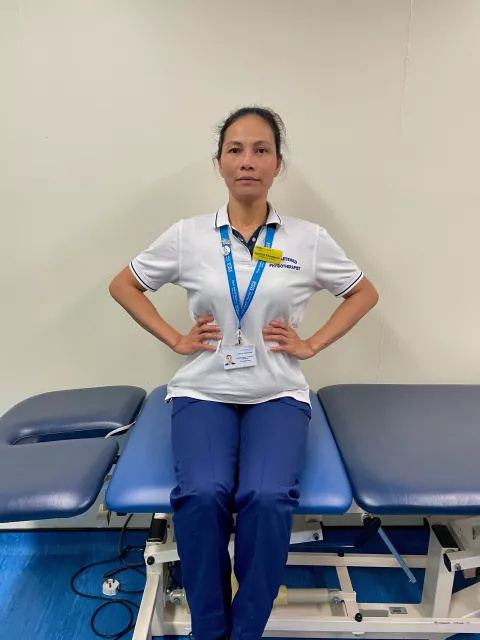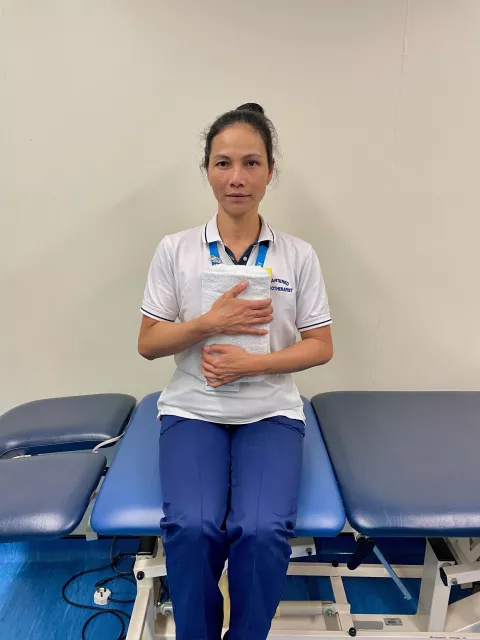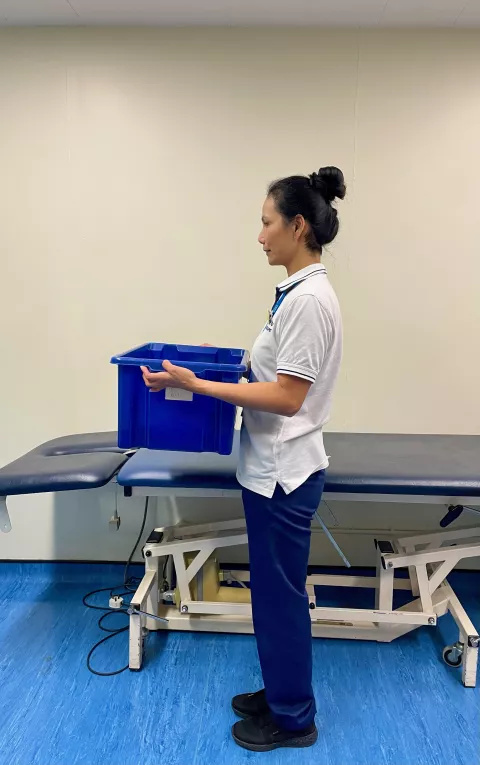Overview
Physiotherapy for heart surgery
Important
These instructions are a general guide. Your consultant may give you different instructions and exercises depending on the type of surgery you have. If you have any questions, please speak to your physiotherapist.
Before your surgery
Practice the breathing exercises before your heart surgery so you get used to doing them. Breathing exercises help to avoid a chest infection.
Breathing exercises
After your surgery you are at risk of a chest infection due to:
- discomfort or pain from your chest wound which can stop you from breathing deeply, and being able to cough.
- not being as mobile as you normally would be for the first few days, so you do not breathe deeply.
You also have an increased risk of a chest infection if you:
- have chronic obstructive pulmonary disease (COPD)
- have a persistent cough causing a build-up of excess mucus (bronchiectasis)
- are a smoker
How to do breathing and supported cough exercises
It is important to clear your chest of phlegm to avoid it becoming infected.

- Sit upright with your hands placed at the bottom of your ribcage.
- Take a deep breath in slowly through your nose.
- Hold the breath for 1 to 2 seconds. Try to sniff in a bit more, and then breathe the air slowly out through your mouth.
- Repeat this 3 to 5 times.
- Then do a huff and a cough.
To do a huff:
- Take a medium sized breath in.
- Then force the air out of your open mouth, as if you are steaming up a window or glass.

To cough:
- Use a towel or pillow to support your chest wound.
- Take a deep breath in and gently cough.
We will encourage you to take regular pain relief. This is important to help you to breathe deeply and cough effectively.
Stop at any time if you feel dizzy.
Moving after surgery
After your surgery you may be attached to monitors, catheters and lines for your medicines and fluid. This is normal and nothing to be concerned about. They should not prevent you from getting up and moving.
- Day 1 after your surgery. The nursing staff will help you get out of bed and sit in a chair.
- Day 2 onwards. We will encourage and assist you to increase your walking.
You will be seen by a physiotherapist before you are discharged to leave hospital. We do not routinely assess how you use stairs, however if it is felt necessary, the physiotherapy team will do this with you.
Looking after your wound
There are a few different ways that your surgeon can reach your heart which depend on the type of procedure you had. Your surgeon will tell you which type you had so you can follow the correct instructions to help your wound to heal.
Sternotomy or hemisternotomy
This is where the breastbone (sternum) and rib cage are opened so the surgeon can reach your heart. After your surgery, we secure the breastbone with sternal wires.
It takes about 3 months for your breastbone to heal fully. It is normal to have new aches, pains and stiffness in the chest, back and neck areas. You may also notice some clicking in these areas.
To move safely after heart surgery, we encourage you to ‘Keep Your Move in the Tube’. Follow these instructions every time you need to lift, carry or push something.

- Imagine having a tube over your upper body and arms
- Keep your arms close to your body to avoid stress on your breastbone.
Examples of load bearing activities are; pushing to stand from a chair, lifting a shopping bag and pushing yourself up from bed.
This will be covered in more detail if you attend our cardiac rehabilitation programme.
Seek medical advice if:
- you notice the clicking getting worse
- your pain is getting worse
- there is pus or redness around the wound
Contact your doctor or GP. If the pain is severe or you feel unwell, please contact your GP, 111 or 999 in an emergency.
Right anterior thoracotomy (RAT), mini thoracotomy, lateral thoracotomy
These are minimally invasive approaches for aortic and mitral valve surgery. The surgeon does not need to open the breastbone and so recovery is quicker. It is usually done through a small opening between the ribs.
You do not have to follow the “Keep Your Move in the Tube” guidance, but there is no risk if you choose to. Listen to your body and stop if any movement is painful.
Minimally invasive direct coronary artery bypass (MIDCAB)
This is a term for a coronary artery bypass graft (CABG) performed without opening the breastbone. This is usually done through a small thoracotomy, which is a cut (incision) made in the chest wall.
You do not have to follow the “Keep Your Move in the Tube”, but there is no risk if you choose to. Listen to your body and stop if any movement is painful.
More information
You can find more information about having heart surgery on our website.
Heart surgery and how to prepare
Resource number: 5478/VER1
Published date: March 2024
Review date: March 2027
